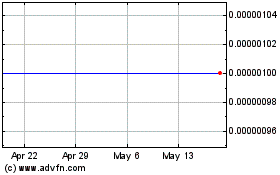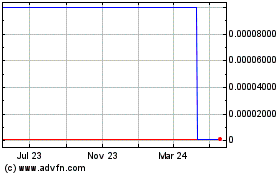Aeolus Announces Additional Data Demonstrating Efficacy of AEOL 10150 as a Medical Countermeasure Against Exposure to Nerve A...
01 July 2014 - 9:30PM
Marketwired
Aeolus Announces Additional Data Demonstrating Efficacy of AEOL
10150 as a Medical Countermeasure Against Exposure to Nerve Agents,
Sulfur Mustard Gas and Nitrogen Mustard Gas
MISSION VIEJO, CA--(Marketwired - Jul 1, 2014) - Aeolus
Pharmaceuticals, Inc. (OTCQB: AOLS)
- Data Presented at 8th Annual NIH Counteract Meeting in
Denver
- Confirmatory Studies In Rats Demonstrate AEOL 10150
Significantly Improves Survival and Lung Function in Sulfur Mustard
Gas Inhalation
- Additional Studies in Mice With Nitrogen Mustard Gas Confirm
That AEOL 10150 Protects Skin From Damage
- Significant Progress Has Been Made Under the $4.3 Million
Counteract Grant to Study AEOL 10150's Efficacy Against Nerve Agent
Exposure
Aeolus Pharmaceuticals, Inc. (OTCQB: AOLS) today announced the
presentation of data confirming the efficacy of AEOL 10150 as a
medical countermeasure sulfur mustard gas inhalation and nitrogen
mustard gas skin exposure. Additionally, an update on progress
under the NIH CounterACT nerve agent grant was provided. The
data was presented at the National Institutes of Health ("NIH")
Countermeasures Against Chemical Threats ("CounterACT") 8th Annual
Conference in Denver, Colorado in June. The data presented are
from studies funded by the CounterACT Program, the National
Institutes of Health Office of the Director, and the National
Institute of Environmental Health Sciences. Aeolus is a
biotechnology company focused on developing compounds to protect
against radiological and chemical threats with significant funding
from the US government.
The key findings presented at the meeting were as follows:
Sulfur Mustard Lung
Program Highlights
- Confirmatory studies were run and verified earlier reported
efficacy of AEOL 10150 in rats exposed to lethal sulfur mustard
gas.
- AEOL 10150 treatment significantly (p < 0.0001) improved
survival at 24 hours after sulfur mustard exposure from 42% vs. 94%
and at 48hrs from 35% to 88%.
- AEOL 10150 treatment significantly (p < 0.0001) improved
lung function 25% to normal levels in sulfur mustard exposed rats
which correlated with arterial blood gas improvements in pO2, pCO2
and pH.
- AEOL 10150 treatment significantly (p < 0.0001) improved
clinical scores 60% in sulfur mustard exposed rats.
- AEOL 10150 treatment reduces airway cast formation at 24 hours
(p < .017) and 48 hours (p <
.0071)
- Brian Day, PhD of National Jewish Health reported on work done
to explore the impact of AEOL 10150 on sulfur mustard exposure
beyond 48 and 72 hours. Research teams led by Dr. Day and Dr.
Carl White, MD at the University of Colorado evaluated the impact
of AEOL 10150 treatment on survival over 28 days at a dose of
sulfur mustard gas that causes 100 percent lethality by day 28
without treatment.
- Natural history studies reveal that the 1.4mg/kg sulfur mustard
gas exposure is 100% lethal by 20 days. AEOL 10150 treatment
increased the median sulfur mustard survival from 2.8 days to 16
days (p < 0.05) with survival of AEOL 10150 treated animals past
28 days.
Nitrogen Mustard Skin
Program Highlights
- Rajesh Agarwal, PhD of the University of Colorado Skaggs School
of Pharmacy and Pharmaceutical Sciences, provided an update on
continuing research of AEOL 10150 as a countermeasure against skin
mustard exposure, which builds on data recently published in the
journal, "Free Radical Biology".
- 1 hour after nitrogen mustard ("NM") exposure, AEOL 10150
ameliorated NM-induced skin injury/morbidity in mice at 24 and 72
hours post-NM exposure.
- AEOL 10150 caused a reduction in NM-induced clinical lesions
including edema, wounded and wrinkled skin areas. There were
decreases of approximately 40% or more in NM-induced increase in
skin bi-fold thickness, percent dead epidermal layer, apoptotic
epidermal cell death, microvesication, and MPO activity (indicating
neutrophil infiltration).
- The therapeutic effects of AEOL 10150 in reversing NM-induced
inflammation and vesication could be associated with DNA damage,
MMP-9 and MAPK/p38 activation, as indicated by our results.
- These studies support further investigation and assessment as
well as optimization of therapeutic potential of AEOL 10150 in the
sulfur mustard skin injury model.
Nerve Agent Program
Highlights
Manisha Patel, PhD of the University of Colorado Skaggs School
of Pharmacy and Pharmaceutical Sciences reported that her research
team had accomplished the key objectives for the first year of the
CounterACT grant "Neuroprotective Effects of AEOL 10150 Against
Organoposphate Toxicity". Dr. Patel reported the DFP rat model
developed in her lab showed significantly increased oxidative
stress parameters in the brain after administration of
DFP. Further, pharmacokinetic ("PK") analysis after
administration of AEOL 10150 one hour after DFP exposure revealed
therapeutic levels of AEOL 10150 in the plasma and the
brain. The levels seen in the presence of DFP were essentially
equivalent to levels seen in the absence of DFP. Work on the
Soman model and the PK profile for AEOL 10150 continues. This
work is funded under NIH Grant #1UO1NS083422-01, a four year $4.3
million grant awarded to Dr. Patel in September 2013.
"The data presented at the CounterACT meeting further confirms
the efficacy of AEOL 10150 as a countermeasure against nerve agents
and mustard gas," stated John McManus, Chief Executive Officer of
Aeolus. "In particular, Dr. White and Dr. Day have repeatedly shown
that AEOL 10150 significantly improves survival after sulfur
mustard exposure in both acute and now longer term models. We
plan on presenting their data and a study design for a pivotal
study in sulfur mustard gas exposure in rodents to the FDA during
the second half of 2014, to get their input on the remaining steps
for approval under the animal rule for this indication. We are
grateful to CounterACT for their support of these studies and to
Drs. Day, Patel, Agarwal, White and their teams for their research
efforts."
The development of AEOL 10150 as a treatment for chemical
vesicant and nerve gas exposure is funded by the National
Institutes of Health's Countermeasures Against Chemical Threats
("CounterACT") program. Aeolus is also developing AEOL 10150
as a treatment for the lung syndrome of Acute Radiation Syndrome
("Lung-ARS") under a five year, cost plus contract with the
Biomedical Advanced Research and Development Authority ("BARDA"), a
division of the U.S. Department of Health and Human
Services. The contract, worth up to $118.4 million, fully
funds the development of AEOL 10150 through approval and licensure
by the U.S. FDA. Aeolus believes that much of the chemistry,
manufacturing and controls, toxicology and safety data generated
under the BARDA contract will be applicable to support a potential
approval of AEOL 10150 as a countermeasure against chemical
threats, in addition to the Lung-ARS indication.
About AEOL 10150
AEOL 10150 is a broad-spectrum catalytic antioxidant
specifically designed to neutralize reactive oxygen and nitrogen
species. The neutralization of these species reduces oxidative
stress, inflammation and subsequent tissue damage resulting from
radiation exposure. The Company believes that AEOL 10150 could have
a profound beneficial impact on people who are exposed to high
doses of radiation.
AEOL 10150 has already performed well in animal safety studies,
was well-tolerated in two human clinical trials and has
demonstrated statistically significant survival efficacy in
multiple studies of the lung syndrome of Acute Radiation Syndrome
in multiple animal species. AEOL 10150 also currently is in
development for use as both a therapeutic and prophylactic drug in
cancer patients.
About Aeolus Pharmaceuticals
Aeolus Pharmaceuticals is developing a new class of
broad-spectrum, catalytic-antioxidant compounds that protect
healthy tissue from the damaging effects of radiation. Its first
compound, AEOL 10150, is being developed, with funding by the US
Department of Health and Human Services, as a medical
countermeasure against chemical and radiological weapons, where its
initial target indications are as a protective agent against the
effects of acute radiation syndrome and delayed effects of acute
radiation exposure. Aeolus' strategy is to leverage the substantial
investment in toxicology, manufacturing, and preclinical and
clinical studies made by US Government agencies in AEOL 10150,
including the contract with BARDA valued, with options, at up to
$118.4 million, to efficiently develop the compound for use in
oncology. For more information, please visit Aeolus's
corporate website at www.aolsrx.com.
Forward-Looking Statements
The statements in this press release that are not purely
statements of historical fact are forward-looking statements. Such
statements include, but are not limited to, those relating to
Aeolus' product candidates, as well as its proprietary technologies
and research programs, the Company's initiation or potential
initiation of large efficacy studies in mice and NHPs, as well as a
phase 1 study in healthy volunteers, the BARDA contract, and the
expected use of proceeds from the financing. Such forward-looking
statements involve known and unknown risks, uncertainties and other
factors that may cause Aeolus' actual results to be materially
different from historical results or from any results expressed or
implied by such forward-looking statements. Important factors that
could cause results to differ include risks associated with
uncertainties of progress and timing of clinical trials, scientific
research and product development activities; difficulties or delays
in development, testing and obtaining regulatory approval; the need
to obtain funding for pre-clinical and clinical trials and
operations; the scope and validity of intellectual property
protection for Aeolus' product candidates, proprietary technologies
and their uses; competition from other biopharmaceutical companies;
and whether BARDA exercises one or more additional options under
the its contract with Aeolus. Certain of these factors and others
are more fully described in Aeolus' filings with the Securities and
Exchange Commission, including, but not limited to, Aeolus' Annual
Report on Form 10-K for the year ended September 30, 2014. Readers
are cautioned not to place undue reliance on these forward-looking
statements, which speak only as of the date hereof.
Contact: John McManus President and Chief Executive Officer
Aeolus Pharmaceuticals, Inc. 1-(949) 481-9820
Aeolus Pharmaceuticals (CE) (USOTC:AOLS)
Historical Stock Chart
From Dec 2024 to Jan 2025

Aeolus Pharmaceuticals (CE) (USOTC:AOLS)
Historical Stock Chart
From Jan 2024 to Jan 2025
